Every weekend when I was little, my mom would come home from the bustling market in Orion, Bataan with small containers of kalamay hati wrapped in banana leaves. The moment she'd unwrap them, that rich coconut aroma would fill our kitchen, and my siblings and I would crowd around for our share of this sticky, sweet treasure.
Years later, living far from home, I found myself craving that exact taste and texture. After countless tries, I finally cracked the code with this simple 3-ingredient version that tastes just like the ones from my childhood.
The best part? You can make this authentic Filipino dessert in just 15 minutes with ingredients you probably already have in your pantry. No more waiting for special trips to the market. Now you can bring this beloved kakanin right to your own kitchen.
Jump to:
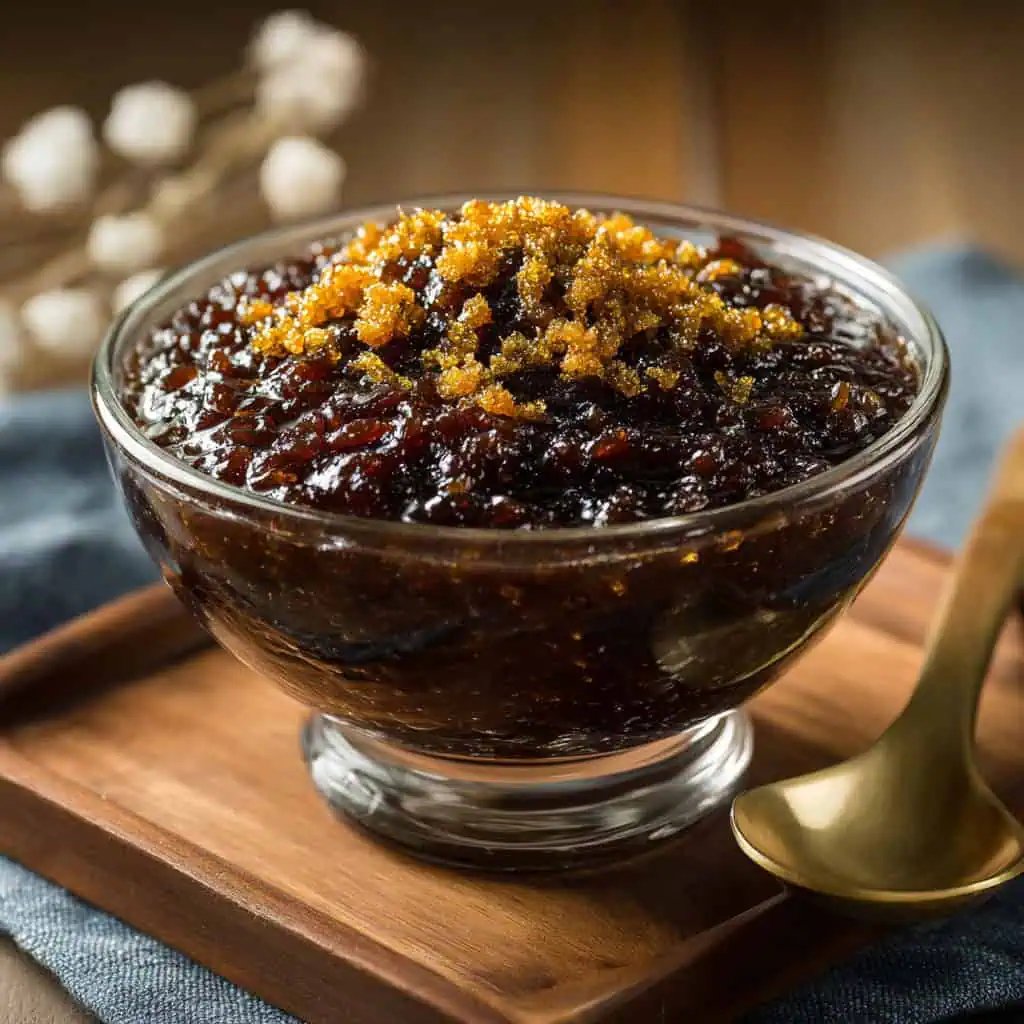
Why You'll Love This Recipe
This simplified Kalamay Hati recipe brings together the best of traditional Filipino flavors without the fuss. You'll love how quick it is - ready in just 15 minutes with only 3 pantry ingredients! The rich coconut flavor combined with the chewy, satisfying texture makes it perfect for any occasion.
Whether you're craving a nostalgic taste of home or introducing friends to Filipino desserts, this foolproof recipe delivers authentic results every time. Plus, it's naturally gluten-free and can be made as fancy or casual as you like.
Ingredients
- 1 cup sweet glutinous rice flour (mochiko brand)
- 1 can (13.5 oz) full-fat coconut milk
- 1 cup coco jam (store-bought or homemade)
- ½ cup crispy latik (optional, for garnish)
- 1 tablespoon coconut oil (for greasing)
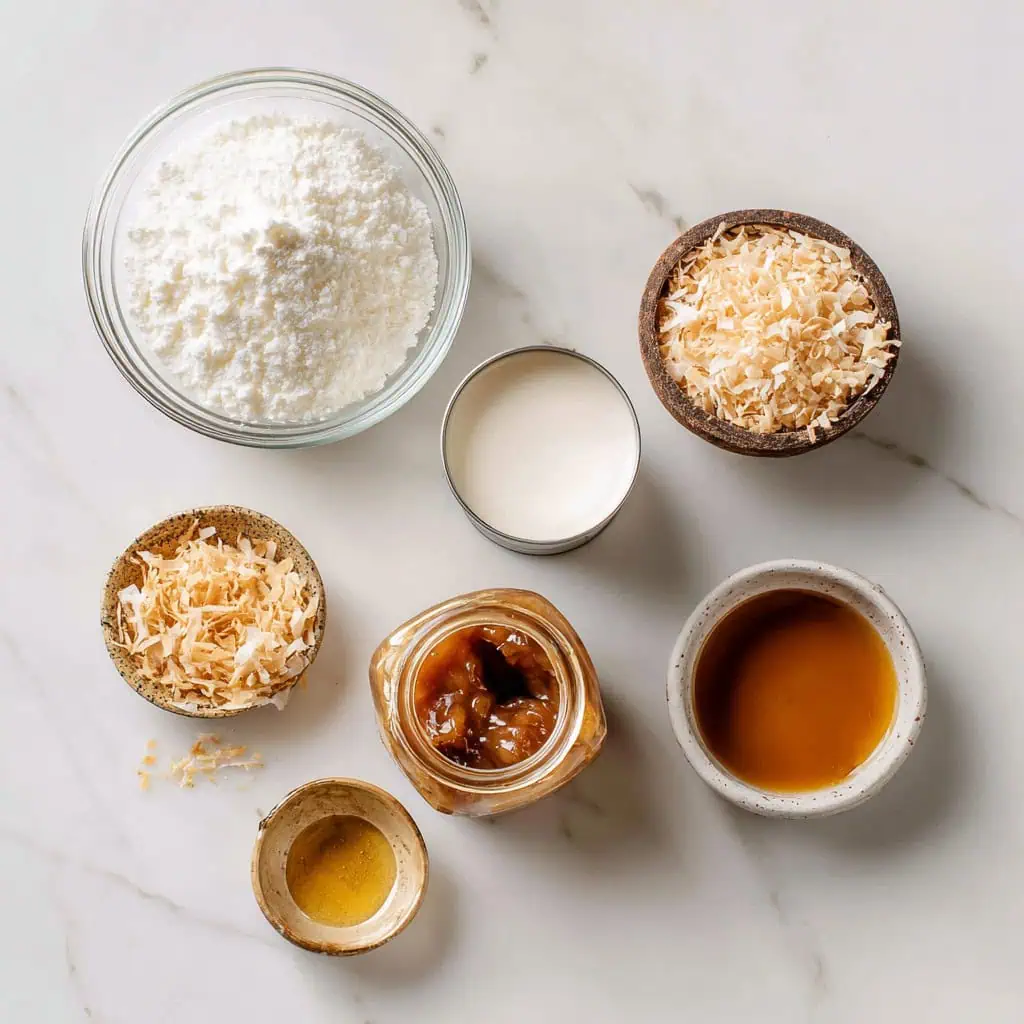
Sweet glutinous rice flour provides the signature chewy texture that makes kalamay so satisfying. Full-fat coconut milk adds richness and authentic tropical flavor, while coco jam replaces traditional muscovado sugar for deeper caramel notes and faster cooking. The crispy latik garnish adds textural contrast and traditional presentation.
Equipment
- Non-stick shallow pan - Prevents sticking and allows for even heat distribution during the constant stirring process
- Silicon whisk - Flexible enough to mix initially without scratching your pan
- Sturdy wooden spoon - Essential for stirring as the mixture thickens and becomes harder to mix
- Serving bowl - Choose something pretty since this dessert looks beautiful when presented well
- Pastry brush - For greasing your serving bowl evenly with coconut oil
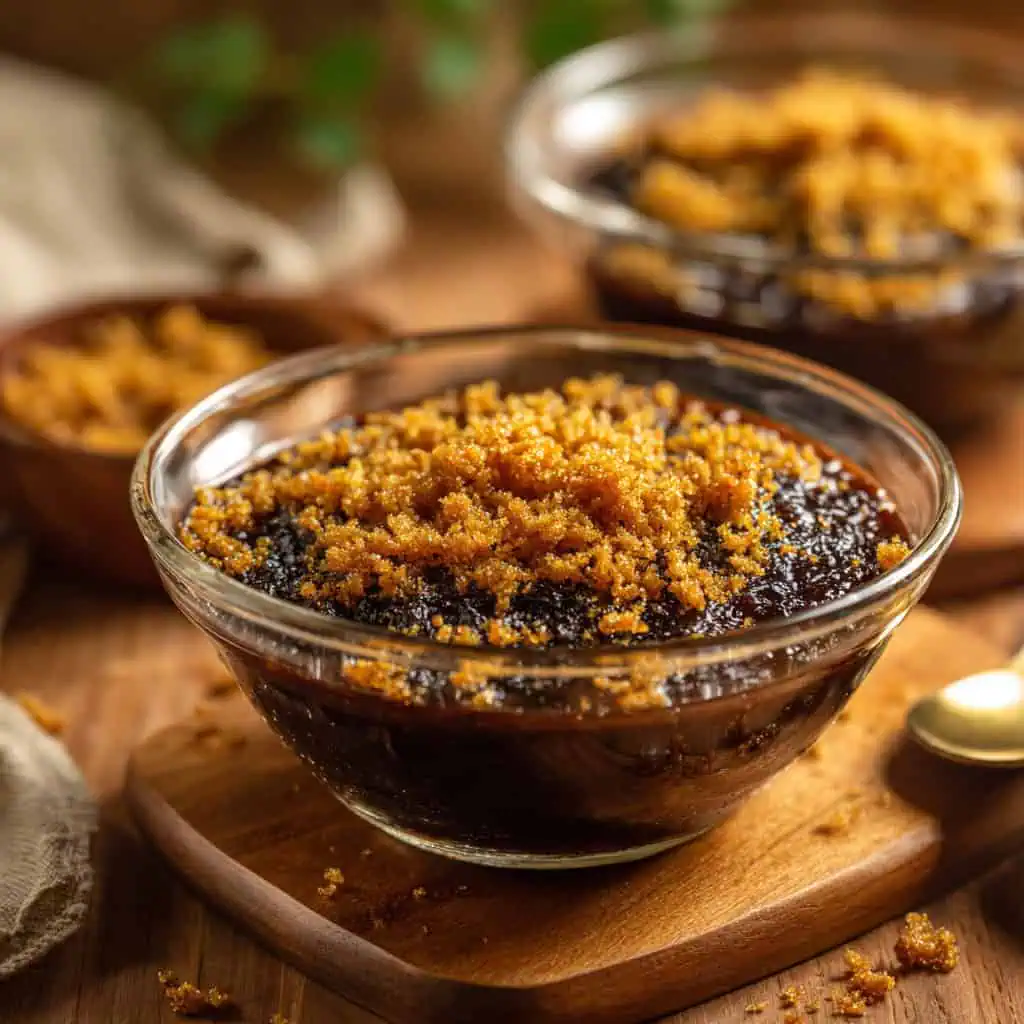
How To Make
- Start by brushing your serving bowl generously with coconut oil, making sure to coat all surfaces. This prevents the kalamay from sticking and makes serving much easier later.
- In your non-stick shallow pan, combine the sweet glutinous rice flour, coconut milk, and coco jam. Mix everything together with your silicon whisk until well combined. Don't worry if you see some coconut lumps - these will melt and disappear during cooking.
- Place the pan on your smallest burner and turn the heat to high. Begin stirring the mixture constantly with your whisk. This constant stirring is crucial to prevent burning and ensure even cooking throughout.
- Continue stirring for about 8 minutes until you notice the oil from the coco jam starting to separate and seep out. At this point, reduce the heat to low to prevent burning while the mixture continues to thicken.
- Switch to your sturdy wooden spoon as the mixture becomes thicker and harder to stir. Keep stirring constantly for another 5 minutes until the kalamay turns a rich dark brown color and holds its shape when you lift the spoon.
- Carefully transfer the hot kalamay into your greased serving bowl. Work quickly but safely as the mixture will be extremely hot. Smooth the top with the back of your spoon if desired.
- Allow the kalamay to cool to room temperature, about 30 minutes. You might notice some coconut oil pooling on the sides, but this will be absorbed back into the kalamay as it cools.
- Just before serving, sprinkle the crispy latik evenly over the top if using. Serve at room temperature with a spoon for the best texture and flavor.

Tips from Lola's Kitchen
- Always use the smallest burner to maintain better heat control
- Never stop stirring once you start cooking - this prevents burning and ensures smooth texture
- Test doneness by lifting the spoon - the mixture should hold its shape for a few seconds
- If mixture seems too thick while cooking, add a tablespoon of coconut milk
- Make crispy latik first if using, as it can be stored and the leftover coconut milk can grease your bowl
- Use a crystal or glass serving bowl to make it look extra special for guests
Substitutions
- Sweet glutinous rice flour: Regular glutinous rice flour works, but texture may be slightly different
- Coco jam: Brown sugar or muscovado sugar (use ¾ cup and cook 5 minutes longer)
- Full-fat coconut milk: Light coconut milk works but will be less rich
- Crispy latik: Toasted coconut flakes or chopped toasted peanuts for crunch
Troubleshooting
- Too runny: Cook 2-3 minutes longer while stirring constantly
- Too thick: Add coconut milk 1 tablespoon at a time while cooking
- Lumpy texture: Strain mixture before cooking or blend briefly
- Burning smell: Lower heat immediately and stir faster
- Oil separation: Normal during cooking, will reabsorb as it cools
Storage & Reheating
- Store covered in refrigerator for up to 5 days
- Bring to room temperature before serving for best texture
- Can be eaten cold, but room temperature is preferred
- Don't freeze as texture becomes grainy when thawed
- Reheat gently in microwave for 10-15 seconds if desired warm
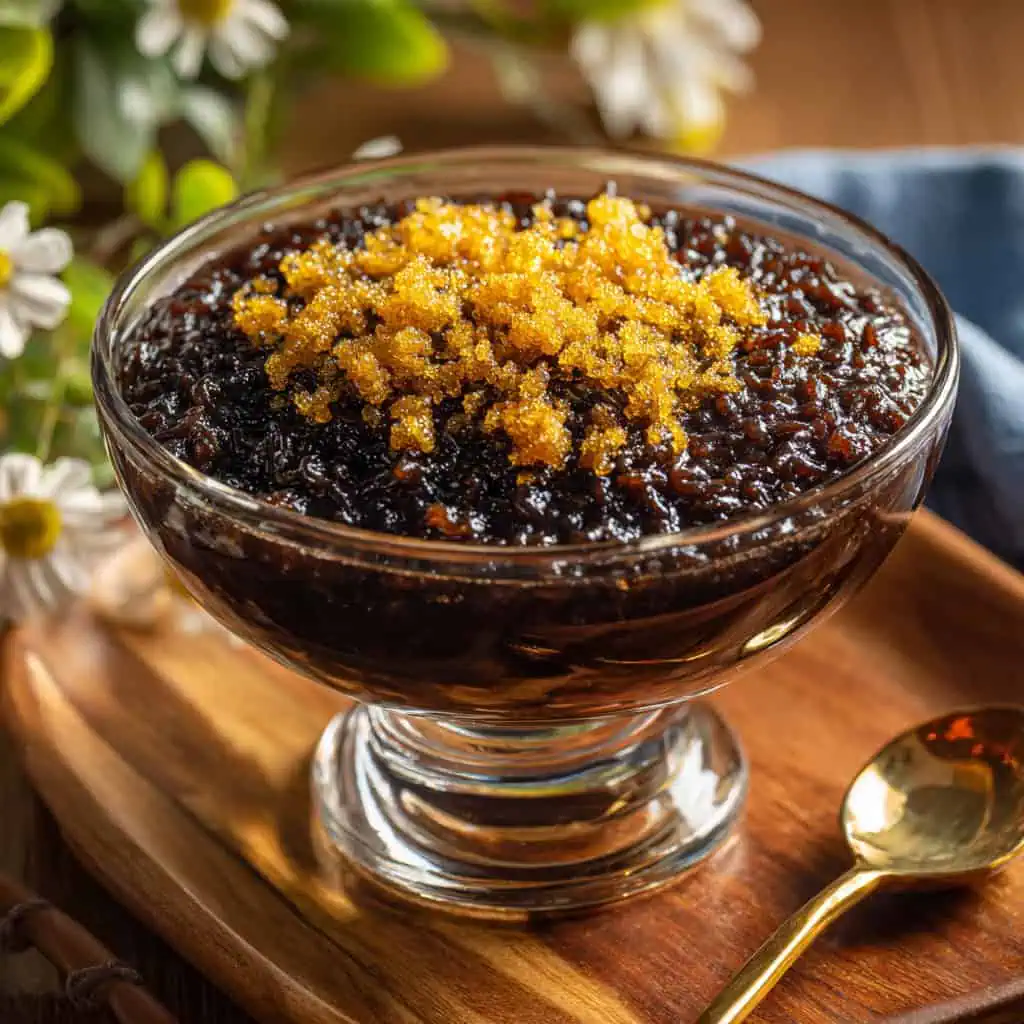
FAQ
Can I make this ahead?
Yes, tastes even better the next day after flavors meld
Why is it called Kalamay Hati?
"Hati" means half in Tagalog, referring to being served in half coconut shells
Is this the same as Sundot-Kulangot?
Very similar, but Sundot-Kulangot is typically more runny
Can I double the recipe?
Yes, but cooking time may increase to 18-20 minutes
What's the difference from other kalamay recipes?
This version uses coco jam instead of raw sugar, making it faster and easier
Related
Looking for other recipes like this? Try these:

Kalamay Hati Recipe (Filipino Coconut Sticky Rice Dessert)
Ingredients
- 1 cup sweet glutinous rice flour mochiko brand
- 1 can 13.5 oz full-fat coconut milk
- 1 cup coco jam store-bought or homemade
- ½ cup crispy latik optional, for garnish
- 1 tablespoon coconut oil for greasing
Instructions
- Start by brushing your serving bowl generously with coconut oil, making sure to coat all surfaces. This prevents the kalamay from sticking and makes serving much easier later.
- In your non-stick shallow pan, combine the sweet glutinous rice flour, coconut milk, and coco jam. Mix everything together with your silicon whisk until well combined. Don't worry if you see some coconut lumps - these will melt and disappear during cooking.
- Place the pan on your smallest burner and turn the heat to high. Begin stirring the mixture constantly with your whisk. This constant stirring is crucial to prevent burning and ensure even cooking throughout.
- Continue stirring for about 8 minutes until you notice the oil from the coco jam starting to separate and seep out. At this point, reduce the heat to low to prevent burning while the mixture continues to thicken.
- Switch to your sturdy wooden spoon as the mixture becomes thicker and harder to stir. Keep stirring constantly for another 5 minutes until the kalamay turns a rich dark brown color and holds its shape when you lift the spoon.
- Carefully transfer the hot kalamay into your greased serving bowl. Work quickly but safely as the mixture will be extremely hot. Smooth the top with the back of your spoon if desired.
- Allow the kalamay to cool to room temperature, about 30 minutes. You might notice some coconut oil pooling on the sides, but this will be absorbed back into the kalamay as it cools.
- Just before serving, sprinkle the crispy latik evenly over the top if using. Serve at room temperature with a spoon for the best texture and flavor.
Tips from Lola's Kitchen
- Always use the smallest burner to maintain better heat control
- Never stop stirring once you start cooking - this prevents burning and ensures smooth texture
- Test doneness by lifting the spoon, the mixture should hold its shape for a few seconds
- If mixture seems too thick while cooking, add a tablespoon of coconut milk
- Make crispy latik first if using, as it can be stored and the leftover coconut milk can grease your bowl
- Use a crystal or glass serving bowl to make it look extra special for guests
The Story Behind Kalamay Hati
Kalamay hati holds a special place in Filipino culinary tradition as one of our most beloved kakanin or rice cakes. This sticky rice dessert has been satisfying sweet cravings across the Philippines for generations, with each region adding its own unique twist to the basic recipe. The name "kalamay hati" literally translates to "half coconut" in Tagalog, a direct reference to how this dessert was traditionally served in halved coconut shells that doubled as both cooking vessel and serving bowl.
The origins of kalamay can be traced back to the pre-colonial Philippines, where indigenous communities first discovered that combining ground glutinous rice with coconut milk and palm sugar created a wonderfully satisfying treat. This simple combination of ingredients made perfect sense in a tropical country where coconuts grew abundantly and rice was a staple crop. The cooking method itself was born from necessity - using coconut shells as natural cookware was both practical and sustainable.
What makes kalamay hati particularly interesting is its close relationship with another famous Filipino dessert called sundot-kulangot, especially popular in Baguio. Both desserts share nearly identical ingredients, glutinous rice, coconut milk, and brown sugar, but differ mainly in texture and consistency. While sundot-kulangot is deliberately kept runny and sticky (hence its amusing name that references its snot-like consistency), kalamay hati is cooked longer to achieve a firmer, more substantial texture that holds its shape.
Regional variations of kalamay can be found throughout the Philippines, from the purple ube kalamay of Bohol to the latik-topped versions popular in Bataan and Pampanga. Each province has perfected its own technique, but the core principle remains the same: transform simple, local ingredients into something extraordinary through patience and technique. Today, kalamay hati continues to be a popular pasalubong or souvenir from various Philippine provinces, often sold in traditional packaging that honors its historical roots.
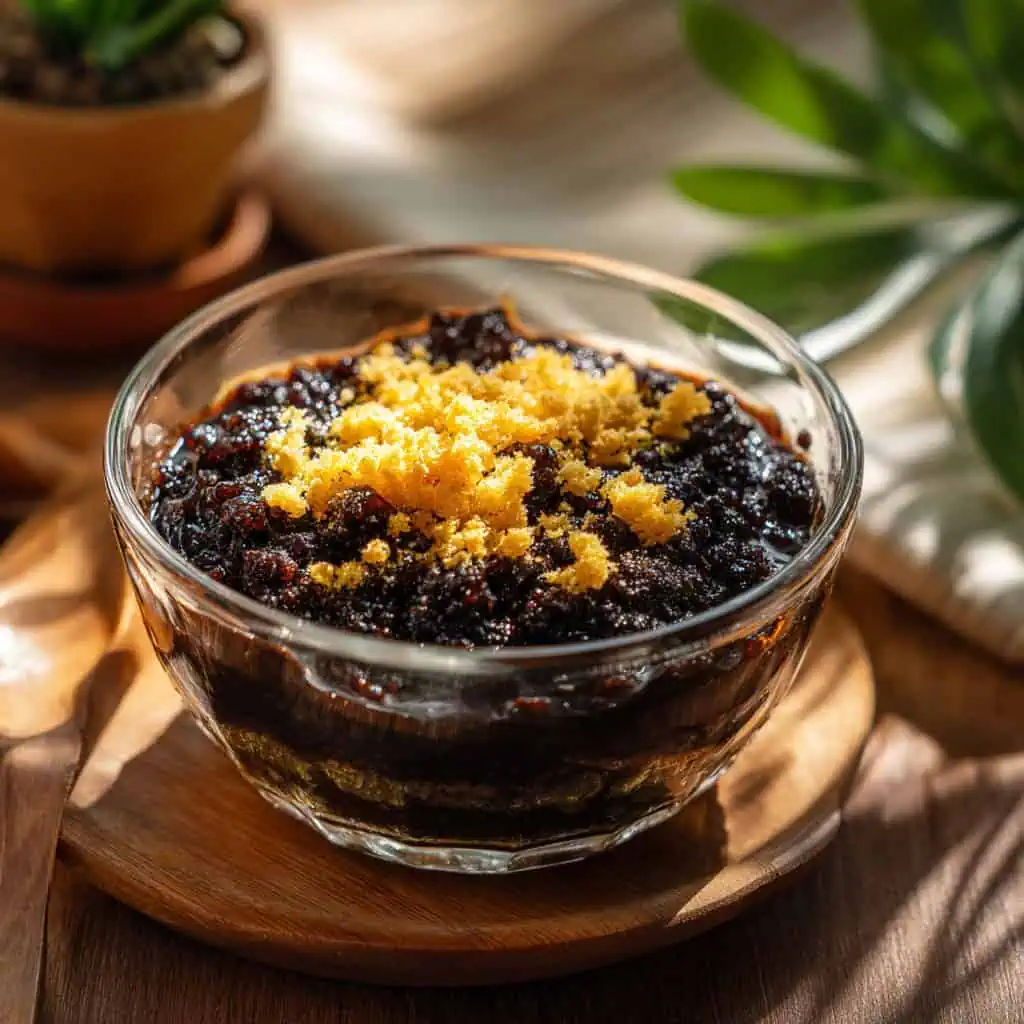






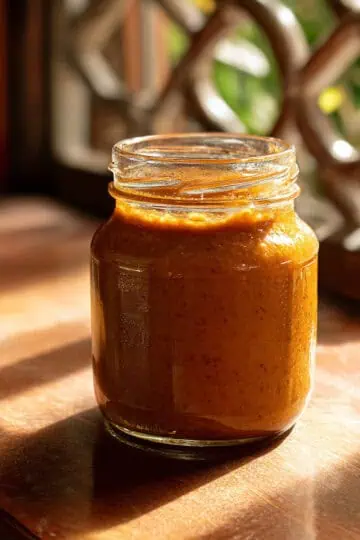


Comments
No Comments